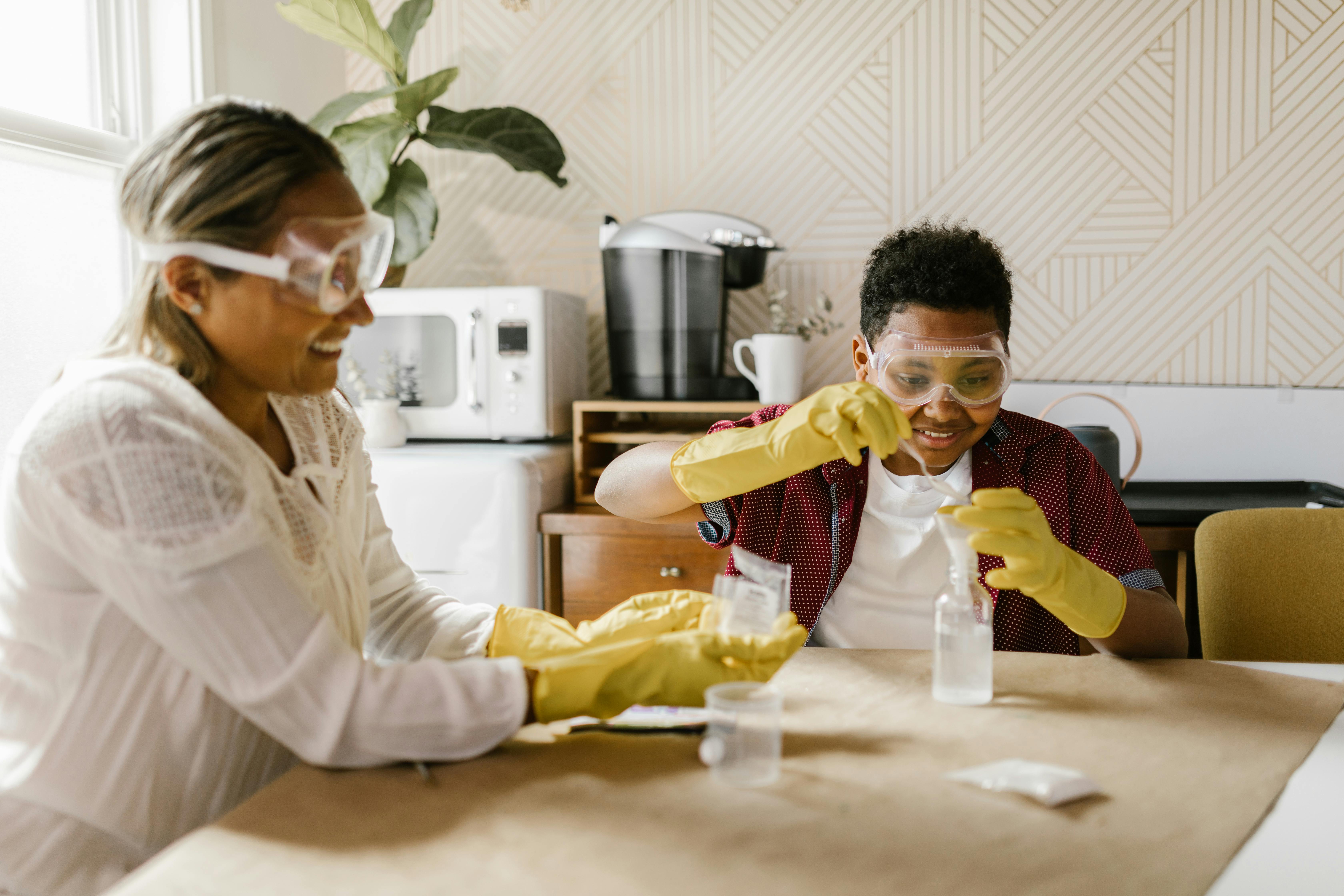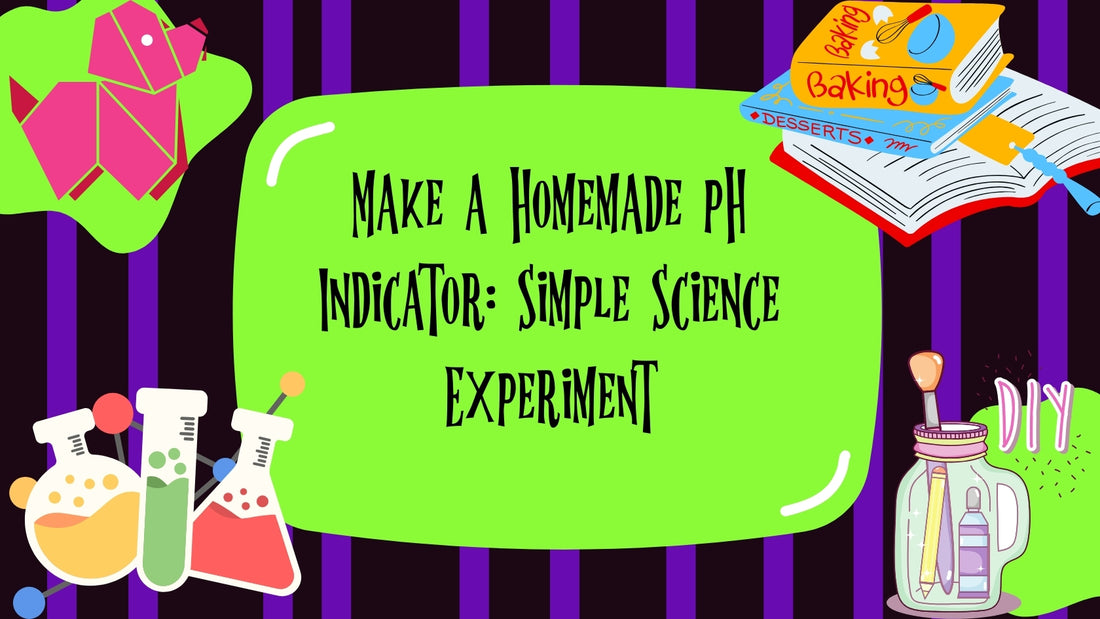As an affiliate, I earn from qualifying purchases, but this doesn't affect the reviews or recommendations—your trust is important to me!
Make a Homemade pH Indicator: Simple Science Experiment

Today, We're Making:
Bullet List
- Homemade pH Indicator
- Homemade Red Cabbage pH Indicator Experiment: This experiment revolves around the use of red cabbage, which serves as a fantastic pH indicator due to a pigment it contains called anthocyanin. Parents can demonstrate the color-changing phenomenon by boiling red cabbage leaves in water, straining the mixture, and segregating the purple solution. This concoction changes color when mixed with different substances indicating whether they are acidic or basic.
- Magic Color Changing Flower Using pH Indicator: In this fun experiment, parents can engage kids by PH coloring white flowers using a homemade PH indicator. Kids will prepare the PH solution using either red cabbage or beetroots.
Ever wondered how to bring the magic of science right into your own kitchen?
Welcome to the captivating world of homemade pH indicators! This simple DIY science experiment not only sparks curiosity but also imparts valuable insights about the cunning chemistry that exists in our everyday surroundings - from the sour lemon to the bitter baking soda.
Navigating the pH scale will no longer be an alien concept confined to high school textbooks.
By making your very own pH test at home, you can explore the fascinating universe of acid-base balance and redefine kitchen science. So grab your lab coat and let's dive into this fun and easy home-based science project.
Get ready to transform common household items into a vivid, edible pH indicator and let your inner scientist shine!
A Simple Science Project: DIY pH Indicator
To kick off this simple science experiment, let's flashback to our chemistry classes where we learned about acids and bases. High on the pH scale, you'll find common household items like baking soda and bleach, these are known as bases. On the contrary, sour elements like lemon and vinegar are found on the lower side of the pH scale, classifying them as acids. The middle of the pH scale, around a neutral pH of 7, is where pure water resides. As an easy science project, think about it as trying to organize a grandiose, colorful party where the high pH bases will be the cool blues and greens, while the acidic, low pH materials plan to strut in with their vibrant red, orange and yellow outfits!
Creating A Homemade pH Indicator
Creating a homemade pH indicator will allow you to identify the acid-base balance in a substance in the most spectacular way - through color! Imagine adding a drop of your homemade indicator into a solution and watching it transform into a full spectrum of colors. Hence, the first candidate for our DIY pH indicator is the red cabbage. Red cabbage is a natural pH indicator due to the presence of a substance named 'Anthocyanin.' This compound reacts with acids and bases resulting in a cool color change.
The Actual Making of a pH Test
Now, let's move to the actual making of a pH test, an exciting part of your home-based science project! All you need is a red cabbage, a knife, blender, strainer, hot water, clear cups, and substances to test their pH. Cut the cabbage into chunks, blend with hot water, then strain the mixture. The purplish-blue liquid you extract is your homemade pH indicator. Highly safe to use, it’s also an excellent option when doing kids science experiments.
Taking Kitchen Science to a Different Level
Taking kitchen science to a different level, experiment using your homemade litmus test to identify acids and bases. Pour your cabbage juice, also your DIY pH indicator, equally into several clear cups. Add lemon juice into one, baking soda into another, and keep adding various household substances into respective cups. You'll be in awe as you witness a mesmerizing color transformation. From beautiful blues and calming greens for bases, to lively reds and oranges for acids, you'll get a blazing display of an edible pH indicator in action - a science education right in your kitchen!
The Best Part About This Home Exeperiment
The best part about this home experiment is the accessibility and ease of procuring the ingredients. With this homemade pH indicator experiment, we’re not only learning chemistry at home but also appreciating the hidden wonders of our everyday items. Suddenly, your kitchen pantry items become magical elements in your home lab, providing not just fun science, but also practical knowledge about the pH scale hidden in the mundane!

Dive into Kitchen Science with DIY pH Indicator Project
In conclusion, science doesn't have to be intimidating or something that only occurs in a distant lab or overheated classroom. With this DIY pH indicator project, we've explored the endless bounds of science that exist precisely where we live and eat - our own kitchen!
Turning ordinary cooking essentials into a magical pH scale, we've witnessed the vibrancy of acids and the calmness of bases in a color spectrum with our homemade indicator, right in our safe home environment. The magic of color, the insight into chemistry, and the joy of learning - the appeal of kitchen science has never been more enticing!
Hopefully, this experiment inspired your inner scientist and piqued your interest in exploring more of such exhilarating kitchen experiments. After all, science resides everywhere; it just needs your curiosity to be brought to light.

You May Also Like These:
Homemade Red Cabbage pH Indicator Experiment
Overview:
This is an exciting and interactive STEM experiment ideal for your curious child who loves to explore and learn. In this experiment, we will make a natural pH indicator using red cabbage and understand how it changes colors with acids and bases.
Ingredients:
- 1/2 head of red cabbage
- Water
- Various household substances (vinegar, baking soda, soap, lemon juice, etc.)
- A pot for boiling
- Strainer
- Clear glasses or test tubes
Instructions:
Step 1: Preparing the pH Indicator
- Chop the red cabbage into small pieces until you have about 2 cups worth.
- Place the chopped cabbage in a pot and add enough water to completely cover the cabbage.
- Heat the pot until the water is boiling, let it boil for about 10 minutes.
- Remove the pot from the heat and let the water cool.
- Using a strainer, strain out the cabbage pieces, collecting the 'juice' in a container. This purple liquid is your pH indicator!
Step 2: Testing the pH Indicator
- Divide the cabbage juice among several clear containers or test tubes.
- Add a different substance to each container: a squirt of lemon juice in one, a spoonful of baking soda in another, some soap, and so on. Stir well.
- Observe the color changes. Acids will turn the cabbage juice pink or red, while bases will turn it green or yellow!
Discuss:
Once your child has observed these fascinating color changes, explain to them why they happened. The red cabbage contains a pigment molecule called flavin which changes color under different pH. Make sure you reinforce that this is how scientists measure the acidity or basicity of unknown liquids!
Red Cabbage PH Indicator STEM Experiment
Objective:
This experiment aims to demonstrate the color-changing phenomenon which results from boiling red cabbage leaves. This change in color is due to a pigment in red cabbage called anthocyanin which serves as a pH indicator.
Materials Required:
- Red cabbage leaves
- Water
- Lemon juice (acidic substance)
- Baking soda (basic substance)
- Stove and pot
- Three glass beakers or clear containers
- Strainer
Procedure:
Step 1: Chop up the red cabbage leaves into small pieces.
Step 2: Place the chopped cabbage into the pot and fill it with enough water to cover the cabbage.
Step 3: Heat the pot on the stove until the water begins to boil, then lower the heat and let it simmer for 30 minutes.
Step 4: After 30 minutes, remove the pot from heat and let it cool. The water should now be a deep purple color.
Step 5: Strain the mixture into a beaker or clear container, separating the cabbage pieces from the liquid. This liquid is your pH indicator!
Step 6: Pour some of the cabbage juice into two additional beakers.
Step 7: Add a small amount of lemon juice to one of these beakers. Expect to see the cabbage juice change color.
Step 8: Add a small amount of baking soda to the other beaker. Again, observe the color change.
Explanation:
The red cabbage contains a pigment called anthocyanin that changes color when it comes in contact with an acid or a base. When the acidic lemon juice was added, it turned the indicator a pinkish-red color. When the baking soda, a base, was added, the indicator turned a greenish-yellow color. This means the color of the cabbage juice depends on the pH of its environment.
STEM Experiment: Straining a Mixture for Kids
Overview
This fun, simple STEM experiment teaches kids about separating mixtures using the straining method. This is an easy, hands-on way to introduce children to basic chemistry concepts at home.
Ingredients
- 1 cup of mixed beans (like kidney, pinto, black beans)
- 1 large bowl
- 1 medium-sized strainer
- Water
Instructions
- Gather all your ingredients: Make sure you have all your ingredients close at hand.
- Prepare the mixture: Pour the mixed beans into the large bowl, and fill it with water until the beans are completely submerged.
- Examining the mixture: Before you strain your mixture, ask your child what they see. This encourages observation – a key part of being a scientist.
- Strain the mixture: Carefully, pour the mixture from the bowl into the strainer. Make sure all the liquid drains into the sink.
- Observe the results: Once you've strained the liquid, you're left with just the beans. Discuss the results with your child - How has the mixture changed? What's left in the strainer? Why?
Conclusion
By doing this experiment, your child learns how a mixture can be separated using a simple tool such as a strainer. This concept is a fundamental aspect in chemistry and process engineering.
Magic Color Changing Flower Using pH Indicator
Ingredients:
- Red Cabbage: As it contains pH indicator that changes color when it comes in contact with acids and bases.
- White Flowers: Choose ones with long, light-colored petals such as daisies or carnations for best results.
- Clear Glasses: Preferably transparent for observing the changes.
- Vinegar: As an acidic substance.
- Baking Soda: As a basic substance.
- Water: For diluting and combining your solutions.
Instructions:
- Firstly, make your pH indicator solution by chopping up the red cabbage into small pieces. Boil the pieces in a pot of water for about 15-20 minutes, until the water takes on a deep purple color. Let this solution cool and then strain it to remove cabbage pieces.
- Next, prepare two different solutions to test on your flowers. Make a basic solution by mixing a spoon of baking soda in a glass of water, and an acidic solution by mixing vinegar in another glass of water.
- Now, trim the stems of your white flowers to fit your glasses and split the stem in two (taking care to not cut through the entire length of the stem).
- Place one part of the split stem in the cabbage juice and the other part of the stem in either the acidic or basic solution. Repeat this step with another flower, but switch the acidic and basic solutions.
- Leave the flowers in their solutions overnight. Observe the changes in color of your flowers the next day! Depending on where they were placed, each side of the flower should change to a different color, indicating the solution's acidity or alkalinity.
- Reflect on your observations. What did you notice about the changes in color? What does this tell you about the liquids you used?
Note: Always ensure adult supervision when using boiling water or sharp objects. It is also crucial to be careful while handling the vinegar and baking soda.
PH Coloring White Flowers: A STEM Experiment for Kids
For this exciting STEM experiment, we're going to use a homemade PH indicator to magically change the color of white flowers! The fun part is that you and your kids will prepare the PH solution at home using simple, readily available ingredients: red cabbage or beetroots. Let's get started!
Ingredients:
- 1 Red Cabbage or 3-4 Beetroots
- White Flowers (daisies, roses, or carnations work great)
- 3 Clear Glass Jars
- Water
- Vinegar
- Baking Soda
Instructions:
- Prepare the PH Indicator: Begin by chopping the red cabbage or beetroots into small pieces. Then, boil these pieces in a pot of water until the water changes color. This should take about 30 minutes.
- Strain the Solution: Once you have a brightly colored liquid, let it cool and strain the solution into the three clear glass jars. You now have a homemade PH indicator.
- Adjust the PH Levels: Into one jar, carefully stir in a small spoonful of baking soda. This will make the solution more alkaline. In another jar, add a few splashes of vinegar to make the solution more acidic. The third jar should remain as it is, acting as your 'control' jar.
- Introduce the Flowers: Now, take your white flowers and trim the stems to fit into your jars. Place one flower in each jar, ensuring the stem is submerged in the solution.
- Observe: Over the next 24 hours, observe the flowers. They will change color according to the PH level of the solution they're in. The flower in vinegar (acidic solution) will turn pink or red, the one in baking soda (alkaline solution) will turn blue or purple, and the one in the control solution should remain white.
And there you have it! A fun, simple, and educational STEM experiment kids can do at home. Happy experimenting!











